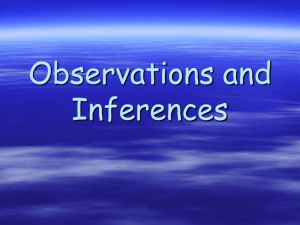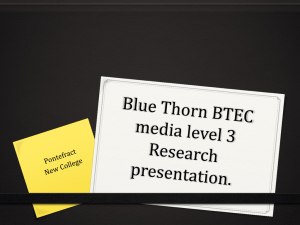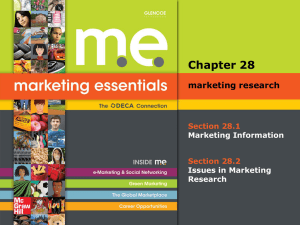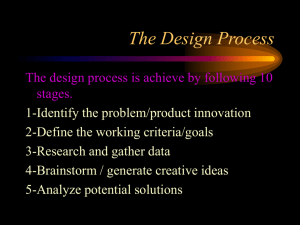advertisement
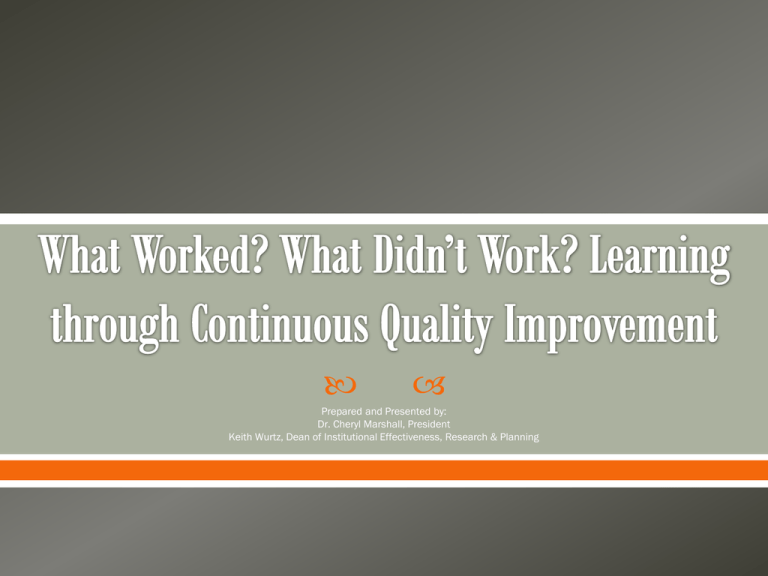
Prepared and Presented by: Dr. Cheryl Marshall, President Keith Wurtz, Dean of Institutional Effectiveness, Research & Planning Briefly describe Crafton’s prior accreditation sanctions Describe a process of systematic continuous improvement, using cycles of dialogue, repeated information gathering, sharing, and re-assessment Provide examples of continuous improvement in program review, strategic planning, and outcomes assessment Discuss the importance of recognizing change as an aspect of continuous quality improvement Provide strategies on how to proactively manage change Integrated Planning o Ed Master Plan o Program Review o District Strategic Plan o District Program Review o District Technology Plan o District HR Plan Data Reliability and Use Achieve Proficiency on Outcomes by 2012 Communication and Shared Governance o Improve and evaluate Resource Allocation o Financial Planning and Transparency Project and Process Champions Focus – Willingness to Prioritize Managing Change Continuous Learning and Improvement Committee Work Systematic and Systemic Approach Communication, Communication, Communication… 1. Gather 1. Gather Data / Data Assess/ Assess 4. Communicate Progress Continuous Quality Improvement 3. Identify Strategies for Improvement 2. Review, Discuss, & Gather Feedback 1. Gather Data / Assess Annual survey administered to the programs completing the four-year action plan Feedback from individuals throughout the year 2. Review, Discuss, & Gather Feedback 3. Identify Strategies for Improvement 4. Communicate Progress 1. Gather Data / Assess Annual survey administered to the programs completing the four-year action plan Feedback from individuals throughout the year 2. Review, Discuss, & Gather Feedback Quantitative Process was more clear and the feedback more useful Qualitative Streamline the questions Provide mentoring and feedback 3. Identify Strategies for Improvement 4. Communicate Progress 1. Gather Data / Assess Annual survey administered to the programs completing the four-year action plan Feedback from individuals throughout the year 2. Review, Discuss, & Gather Feedback Quantitative Process was more clear and the feedback more useful Qualitative Streamline the questions Provide mentoring and feedback 3. Identify Strategies for Improvement Questions were revised and reduced Created PPR Committee Contacts to provide support and feedback Added workshops and open meetings 4. Communicate Progress 1. Gather Data / Assess Annual survey administered to the programs completing the four-year action plan Feedback from individuals throughout the year 2. Review, Discuss, & Gather Feedback Quantitative Process was more clear and the feedback more useful Qualitative Streamline the questions Provide mentoring and feedback 3. Identify Strategies for Improvement Questions were revised and reduced Created PPR Committee Contacts to provide support and feedback Added workshops and open meetings 4. Communicate Progress Email Workshops Committee Contacts At the Water Cooler In Service Meetings with Programs Multiple Committee Meetings (e.g.: Chairs) Repeat 1. Gather Data / Assess Annual survey administered to the programs completing the four-year action plan Feedback from individuals throughout the year 2. Review, Discuss, & Gather Feedback 3. Identify Strategies for Improvement 4. Communicate Progress 1. Gather Data / Assess Annual survey administered to the programs completing the four-year action plan Feedback from individuals throughout the year 2. Review, Discuss, & Gather Feedback Quantitative Timelines were more clear Web Tool is more difficult to use Qualitative Questions were the same just asked in a different way Develop a streamlined review for outcomes Only provide one place where outcomes can be reported Provided a quick link to PPR 3. Identify Strategies for Improvement 4. Communicate Progress 1. Gather Data / Assess Annual survey administered to the programs completing the four-year action plan Feedback from individuals throughout the year 2. Review, Discuss, & Gather Feedback Quantitative Timelines were more clear Web Tool is more difficult to use Qualitative Questions were the same just asked in a different way Develop a streamlined review for outcomes Only provide one place where outcomes can be reported Provided a quick link to PPR 3. Identify Strategies for Improvement Questions were revised and streamlined Web Tool is now only place where campus is required to report outcomes Quick Link added to Crafton home page Improved Objective Prioritization aspect of Web Tool to make more user friendly 4. Communicate Progress 1. Gather Data / Assess Annual survey administered to the programs completing the four-year action plan Feedback from individuals throughout the year 2. Review, Discuss, & Gather Feedback Quantitative Timelines were more clear Web Tool is more difficult to use Qualitative Questions were the same just asked in a different way Develop a streamlined review for outcomes Only provide one place where outcomes can be reported Provided a quick link to PPR 3. Identify Strategies for Improvement Questions were revised and streamlined Web Tool is now only place where campus is required to report outcomes Quick Link added to Crafton home page Improved Objective Prioritization aspect of Web Tool to make more user friendly 4. Communicate Progress Email Workshops Committee Contacts At the Water Cooler In Service Meetings with Programs Multiple Committee Meetings (e.g.: Chairs) Repeat 1. Gather Data / Assess Campus Climate Survey administered every other Fall Collaboratively developed and feedback ellicited from entire campus 2. Review, Discuss, & Gather Feedback 3. Identify Strategies for Improvement 4. Communicate Progress 1. Gather Data / Assess Campus Climate Survey administered every other Fall Collaboratively developed and feedback ellicited from entire campus 2. Review, Discuss, & Gather Feedback Results shared with Campus and Feedback Gathered Report Presentations Newsletter Workshops Numerous Committee Meetings 3. Identify Strategies for Improvement 4. Communicate Progress 1. Gather Data / Assess Campus Climate Survey administered every other Fall Collaboratively developed and feedback ellicited from entire campus 2. Review, Discuss, & Gather Feedback Results shared with Campus and Feedback Gathered Report Presentations Newsletter Workshops Numerous Committee Meetings 3. Identify Strategies for Improvement Crafton Council Reviewed feedback Selected strategies to implement Assigned responsible person Monitored Status 4. Communicate Progress 1. Gather Data / Assess Campus Climate Survey administered every other Fall Collaboratively developed and feedback ellicited from entire campus 2. Review, Discuss, & Gather Feedback Results shared with Campus and Feedback Gathered Report Presentations Newsletter Workshops Numerous Committee Meetings 3. Identify Strategies for Improvement 4. Communicate Progress Crafton Council Reviewed feedback Selected strategies to implement Assigned responsible person Monitored Status Email Workshops Committee Contacts At the Water Cooler In Service Meetings with Programs Multiple Committee Meetings (e.g.: Chairs) Repeat Examples of Progress on Implementing Suggestions from the Fall 2010 Campus Climate Survey Suggestion Progress Make applause cards readily available for use. A link to the Applause Cards is available on the Navigator Online Resource Web Site. Training for managers on recognition Training occurred on Friday, November 9th, 2012. Committee chairs should be trained how to run a committee. Training occurred on August 22nd, 2012. Future trainings will occur once every primary term. The ability to search the email database by first name, department, or office. Contacted DCS in Fall 2012. When click on “To”, check “More columns” and enter first name. “Bring a friend” to committee meetings. Where the friend can sit in on committee as a guest. Piloted in Spring 2012, and did not work well. 100% 90% 80% 70% 60% 50% 40% 30% 20% 10% 0% Fall 2010 92% 86% 78% 58% Fall 2012 81% 81% 76% 81% 71% 63% 60% 49% 52% 50% 100% % Agree/Strongly Agree 90% 80% 70% Fall 2010 Fall 2012 74% 91% 89% 73% 60% 50% 40% 30% 20% 10% 0% CHC uses the results from the SLOs to improve CHC uses the results from the SLOs to improve student learning programs and services “Create one central repository for all SLO's. Currently, I have four locations to which each SLO is recorded.” “Right now the procedure for submitting seems to be whatever you want, however you want, wherever you want. For faculty wanting direction, this is confusing. For anyone wanting to review outcomes for the institution, it is a barrier.” “Streamlining outcomes assessment is the most important part. As a faculty member, I am always assessing my methods, and make changes accordingly. The SLOs help with that, although they are extra work for the most part.” “The outcomes assessment process continues to grow and improve; however, I think that we can continue to make the reporting process easier.” 100% % Agree/Strongly Agree 90% 80% Fall 2010 Fall 2012 70% 66% 60% 50% 40% 30% 20% 52% 44% 57% 49% 32% 10% 0% Communication across campus Communication & understanding is timely and accurate. among the different employee constituency groups at CHC is sufficient. Best practices are shared effectively at CHC. “Although communication has improved somewhat, there is still the feeling that any input we may have really isn't taken into consideration when decisions are being made, even when the decision directly affects our job. There are also times when we are told of a decision that was made without seeking any input from the person or area that will be affected the most.” “Communication is improving. “One thing that is new is the prevalence of newness, the changing scale and scope of change itself, so that the world alters as we walk in it.” ~ Robert Oppenheimer “Today, loving change, tumult, even chaos is a prerequisite for survival, let alone success…change by everyone requires a dramatic increase in the capacity to accept disruption.” ~ Tom Peters “If you do not change direction, you may end up where you are heading.” ~ Lao Tzu “Change will not come if we wait for some other person or some other time. We are the ones we've been waiting for. We are the change that we seek.” ~ Barack Obama “Change is the only constant.” What changes have you experienced over the last 12 months? In what ways have you welcomed the change? What were the benefits of the change? What were the disadvantages? How have you or others resisted the change? Personal Change: Intentional, purposeful adoption of new thoughts & behaviors Organizational Change: Adoption of new ideas or behavior by an organization in response to opportunities or threats No sense that it is needed Short term thinking Sense of loss Comfort zones Personal habits and characteristics Question 1. Are you currently using the latest version of software on your home computer? 2. Have you driven to work using a different route in the last 3 months? 3. Have you taken a new workshop? 4. Have you tried new food in the past 6 months? 5. Have you changed the arrangement of your furniture? 6. Have you read a new publication the past year? 7. Have you changed your hair style or color? Yes No Activists Thrill Seeker Idea Generator Pot Stirrer Rivals Naysayer Traditionalist Passive Aggressive Disengaged Denial Awareness Perceived Need Resistance Action Commitment Recognize formal and informal leaders Provide opportunities for participation and leadership at all levels of the organization Include and retain students and staff on key committees Provide vision Communicate, communicate, communicate! Look at both technical and human systems Celebrate successes Lack of vision Lack of understanding Too much change at ounce Lack of clear communication Poor management of resistance All talk and no action Internal focus – Losing sight of the customer Not including key people What Didn’t Work? What Worked? Trying to do everything Hiring a consultant (Relieved workload and helped with facilitation of process) What Didn’t Work? What Worked? Trying to do everything Hiring a consultant (Relieved workload and helped with facilitation of process) Communicating in only one format Communication needs to happen often, occur in as many formats as possible, and be repeated over and over again What Didn’t Work? What Worked? Trying to do everything Hiring a consultant (Relieved workload and helped with facilitation of process) Communicating in only one format Communication needs to happen often, occur in as many formats as possible, and be repeated over and over again Assuming that people will notice when their idea was implemented Need to specifically credit people for their suggestions individually and in public whenever the opportunity presents itself What Didn’t Work? What Worked? Trying to do everything Hiring a consultant (Relieved workload and helped with facilitation of process) Communicating in only one format Communication needs to happen often, occur in as many formats as possible, and be repeated over and over again Assuming that people will notice when their idea was implemented Need to specifically credit people for their suggestions individually and in public whenever the opportunity presents itself Looking at only quantitative information Qualitative information from open-ended surveys and workshops is often the most informative What Didn’t Work? What Worked? Trying to do everything Hiring a consultant (Relieved workload and helped with facilitation of process) Communicating in only one format Communication needs to happen often, occur in as many formats as possible, and be repeated over and over again Assuming that people will notice when their idea was implemented Need to specifically credit people for their suggestions individually and in public whenever the opportunity presents itself Looking at only quantitative information Qualitative information from open-ended surveys and workshops is often the most informative Holding open workshops Getting on the agenda at multiple committee meetings and presenting the same information multiple times What Didn’t Work? What Worked? Trying to do everything Hiring a consultant (Relieved workload and helped with facilitation of process) Communicating in only one format Communication needs to happen often, occur in as many formats as possible, and be repeated over and over again Assuming that people will notice when their idea was implemented Need to specifically credit people for their suggestions individually and in public whenever the opportunity presents itself Looking at only quantitative information Qualitative information from open-ended surveys and workshops is often the most informative Holding open workshops Getting on the agenda at multiple committee meetings and presenting the same information multiple times Ignoring the challenges that Planning for the challenges that go along with go along with change change and devising strategies prior to change Managing crises and cultural change take a lot of work Be strategic and thoughtful Keep watch on the organization’s pulse Hold people accountable Communication must be systemic and continuous Include as many people as possible Pick your battles Take care of yourself Keith Wurtz o Crafton Hills College o Dean, Institutional Effectiveness, Research & Planning o 909-389-3206 o kwurtz@craftonhills.edu Cheryl Marshall o Crafton Hills College o President o 909-389-3200 o cmarshal@craftonhills.edu

